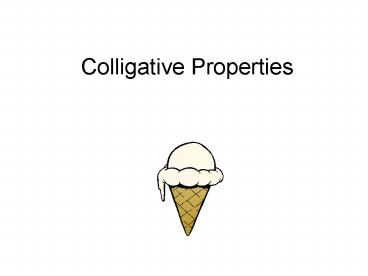Colligative Properties PowerPoint PPT Presentation
1 / 15
Title: Colligative Properties
1
Colligative Properties
2
Colligative Properties.
- Are properties that depend on the number of
dissolved particles only. - The type of dissolved particles does not matter
3
Freezing Point
- The temperature at which a solution freezes from
a liquid to a solid - Freezing point of pure water is 0o C
- Adding a solute to pure water lowers the freezing
point below zero
4
Freezing Point is lowered when
- Salt is added to roads in winter, so they dont
get icy even if the temp is below zero - Antifreeze is added to engine fluids so they
dont freeze inside your engine and your car
still starts when the temp is below zero
5
Take 1000g of pure water
- And add one mole of dissolved particles, and you
will lower the freezing point by 1.86 degrees C. - Remember it does not matter what the dissolved
particles are, only how many there are!!!
6
Boiling Point
- The temperature at which a solution boils from a
liquid to a gas - Boiling point of pure water is 100o C
- Adding a solute to pure water raises the boiling
point above 100 degrees C
7
Boiling Point is raised when
- Salt is added boiling water to cook pasta faster
(at a higher temperature) so the pasta does not
get soggy. Instead it comes out al dente - Antifreeze is added to engine fluids so they
dont boil inside your engine and your car wont
overheat when temp is above 100 degrees C.
8
Take 1000g of pure water
- And add one mole of dissolved particles, and you
will raise the boiling point by 0.52 degrees C. - Remember it does not matter what the dissolved
particles are, only how many there are!!!
9
Some solutes are more effective than others at
raising and lowering boiling and freezing points
- I mole of sugar (covalent compound) dissolves in
water to form 1 mole of dissolved sugar
C6H1206(aq) - 1 mole of NaCl (ionic compound) will dissolve to
form 2 moles of dissolved particles 1 mole of
Na (aq) and I mole of Cl- (aq)
10
Some solutes are more effective than others at
raising and lowering boiling and freezing points
- 1 mole of CaCl2 (ionic compound) will dissolve to
form 3 moles of dissolved particles 1 mole of
Ca (aq) and 2 moles of Cl- (aq) - In general, ionic compounds form more dissolved
particles, so they are a better choice for adding
to the water to change boiling or freezing points.
11
Vapor Pressure Table H
- some molecules at the surface of a liquid
- may have enough energy to evaporate even
- if the liquid is below its boiling point. These
- escaping gas particles exert a pressure called
VAPOR PRESSURE.
12
Vapor Pressure
- The more easily the molecules evaporate, the
higher the vapor pressure - The weaker the intermolecular forces, the more
easily the molecules can separate and go into the
gas phase, therefore the higher the vapor pressure
13
Vapor Pressure
- The more easily the molecules evaporate, the
higher the vapor pressure - The stronger the intermolecular forces, the less
easily the molecules can separate and go into the
gas phase, therefore the lower the vapor pressure
14
Using Table H
- Which liquid has the highest vapor pressure at 50
degrees? - The lowest?
- Which liquid has the weakest intermolecular
forces? - The strongest?
15
Vapor pressure
- The boiling point of a liquid is defines as the
temperature at which the vapor pressure of the
liquid equals atmospheric pressure (1 atm or
101.3 kPa) - In other words, at that temp all the molecules
change to gas phase (boil), not just the
molecules at the surface

